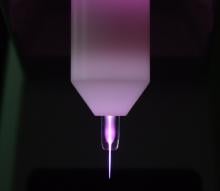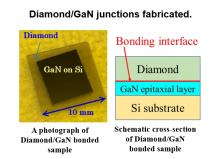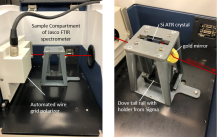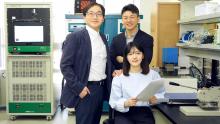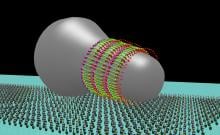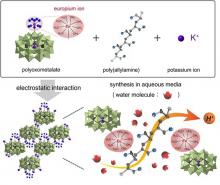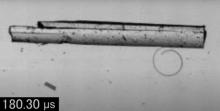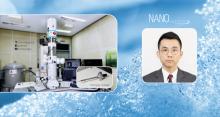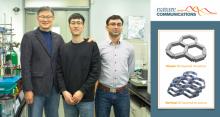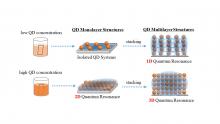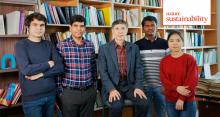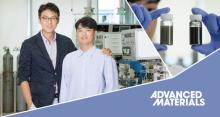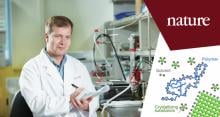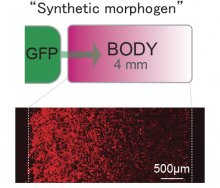Engineering & Technology Chemical Engineering
News
19 Oct 2021
When liquid meets gas, a unique zone forms. Variable by nature, molecules can cross from one state to another, combining in unique ways to either desirable or unwanted ends. From heat escaping a mug of coffee to increasing molecular concentrations in chemical solutions, gas-liquid interfaces are ubiquitous across nature and engineering. But a lack of tools capable of precisely controlling such gas-liquid interfaces limit their applications — until now.
09 Sep 2021
Researchers succeed in the direct bonding of diamond and gallium nitride (GaN) at room temperature and demonstrate that the bond can withstand heat treatments of 1,000℃, making it ideal for the high temperature fabrication process of GaN-based devices. GaN-on-diamond semiconductor material will allow for the next generation of high power, high frequency devices.
02 Aug 2021
The Research Center for Thin Film Solar Cell, DGIST succeeded achieving the world’s highest PCE of 12.2% for flexible CZTS thin film solar cells.
17 Jun 2021
Researchers at Osaka Prefecture University have established an approach to identify the orientation of molecules and chemical bonds in crystalline organic-inorganic hybrid thin films deposited on substrates using Fourier transform infrared spectroscopy (FT-IR) and polarized infrared light with a 3D-printed attenuated total reflectance (ATR) unit. This inexpensive method with laboratory-grade equipment quickly reaches the crystal-structure model of even extremely thin films of less than 10 nm.
01 Jun 2021
Researchers from Korea utilized LiNO3 pre-planted lithium particles to design a stable, long-lasting lithium metal battery
24 May 2021
In collaboration with Kanazawa University, researchers from Osaka City University used high-speed atomic force microscopy (HS-AFM) to visualize at the nanometer level the movement of individual particles within the parasitic bacterium Mycoplasma mobile. After confirming the outline on the surface of the cell structure in an immobilized state with previous data gathered from electron microscopy, the team succeeded in visualizing the real-time movements of the internal structure by scanning the outside of the cell with HS-AFM.
20 Apr 2021
Protons are the next big thing when it comes to fuel cell technology. The subatomic exchange produces power on a scale that challenges contemporary solid-state fuel cell technology, used to help power space shuttles. To realize the proton-based technology sooner, an international team of researchers have developed a hybrid material that effectively transports protons at high temperatures and humidity — two major challenges in past attempts.
19 Apr 2021
Researchers discovered, while exploring the photomechanical properties of diarylethene, that under irradiation with UV light the crystal of the compound peels off into micrometer sized crystals at a world’s fastest speed of 260 microseconds. As the material returns to its former molecular structure when exposed to visible light, the exfoliation method positions itself as a candidate for photoactuator manufacturing.
20 Nov 2020
A research team, affiliated with South Korea's Ulsan National Institute of Science and Technology (UNIST) has recently reported a significant discovery that could bring solar hydrogen production a step closer to reality.
20 Nov 2020
A research team, affiliated with South Korea's Ulsan National Institute of Science and Technology (UNIST) has introduced a novel responsive system, capable of molecular recognition of physicochemically similar mixtures, such as isotopes.
20 Nov 2020
A research team, affiliated with South Korea's Ulsan National Institute of Science and Technology (UNIST) has presented a new class of efficient catalysts, made from inexpensive carbon compounds and ruthenium (Ru).
20 Nov 2020
A research team, affiliated with South Korea's Ulsan National Institute of Science and Technology (UNIST) has succeeded in analyzing the structure of the sulfide-based solid electrolytes (SEs) at the atomic level.
20 Nov 2020
A research team, affiliated with South Korea's Ulsan National Institute of Science and Technology (UNIST) has developed a ‘carbon-based high-efficiency electrochemical catalyst’ for use to produce H2O2.
20 Nov 2020
A research team, affiliated with South Korea's Ulsan National Institute of Science and Technology (UNIST) has proposed a new experimental approach for estimating the H‐bond free energy of local biological water.
20 Nov 2020
A research team, affiliated with South Korea's Ulsan National Institute of Science and Technology (UNIST) has designed and synthesized a vertical two-dimensional (2D) layered structure to develop materials that exhibit excellent performance in terms of gas storage and for the removal of toxic substances.
20 Nov 2020
A recent study, affiliated with South Korea's Ulsan National Institute of Science and Technology (UNIST) has succeded in developing high-performance perovskite oxide catalysts, using late transition metal oxide materials.
19 Nov 2020
Scientists have found a way to control an interaction between quantum dots that could lead to more efficient solar cells.
19 Nov 2020
A recent study, affiliated with South Korea's Ulsan National Institute of Science and Technology (UNIST) has unveiled a highly-flexible and durable electrode using the dream material, graphene.
19 Nov 2020
A recent study, affiliated with South Korea's Ulsan National Institute of Science and Technology (UNIST) has introduced a novel catalyst synthesis method, capable of generating hydrogen from yeasts, the main microorganisms involved in alcohol and bread fermentation.
19 Nov 2020
A research team, affiliated with South Korea's Ulsan National Institute of Science and Technology (UNIST) has identified a new metabolic pathway, in which microorganisms utilize single carbon (C1) gases (CO and CO2) as a feedstock.
19 Nov 2020
A research team, affiliated with South Korea's Ulsan National Institute of Science and Technology (UNIST) has succeeded in synthesizing 1T‐phase TMDs via molten‐metal‐assisted intercalation (MMI).
19 Nov 2020
A recent study, affiliated with South Korea's Ulsan National Institute of Science and Technology (UNIST) has demonstrated that in the presence of polymers (preferably, polyionic liquids), crystals of various types grow in common solvents, at constant temperature, much bigger and much faster when stirred, rather than kept still.
19 Nov 2020
A recent study, affiliated with South Korea's Ulsan National Institute of Science and Technology (UNIST) has unveiled a new water-splitting hydrogen catalyst, namely Ru@MWCNT.
19 Nov 2020
A recent study, affiliated with South Korea's Ulsan National Institute of Science and Technology (UNIST) has presented new electrolyte additives for high-performance LIBs that would enable an electric vehicle (EV) to travel longer distances on a single charge.
19 Nov 2020
A research team, affiliated with South Korea's Ulsan National Institute of Science and Technology (UNIST) has presented an external-power-free single-structured PRB, named a dye-sensitized photo-rechargeable battery (DSPB) with an outstanding light-to-charge energy efficiency (ηoverall) of 11.5% under the dim light condition.
17 Nov 2020
Scientists explain how selective electrostatic doping can balance the charge in optoelectronic devices with 2D materials
20 Oct 2020
Researchers at Kanazawa University and University of California, San Francisco report in Science that arbitrary proteins, when combined with anchoring and receptor proteins, can work as a signaling protein “morphogen” capable of engineered spatial patterning.
26 Mar 2020
In a recent study published in Autophagy, researchers at Kanazawa University show how abnormalities in a gene called TPR can lead to pediatric brain cancer
02 Mar 2020
A recent study, affiliated with South Korea's Ulsan National Institute of Science and Technology (UNIST) has unveiled a novel catalyst (Pt1/CNT) for electrochemical chlorine generation.
Events
Sorry, nothing coming up for this discipline
Researchers
Sorry, nothing coming up for this discipline
Giants in history
Sorry, nothing coming up for this discipline


